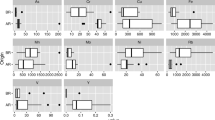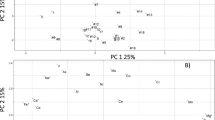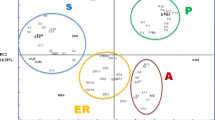Abstract
The profile and level of 11 biogenic amines were evaluated in commercial fruit juices (apple, grapefruit, orange and pineapple) and fruit nectars (apricot, peach and pear) by HPLC/FD after dansyl chloride derivatization. The biogenic amine most present in nectars is cadaverine, followed by putrescine, spermidine and spermine. Fruit juices showed a wider variability in biogenic amines profile and level, with the highest total content in orange juices. The application of chemometric tools as hierarchical cluster analysis and principal component analysis on the biogenic amine profiles of the juice samples succeeded in grouping juices on the basis of the fruit of origin. A mathematical model with high predictive ability for fruit juices classification was obtained by linear discriminant analysis: orange (100 %), pineapple (100 %), grapefruit (80 %) and apple (70 %). This study represents the first description of biogenic amines content in these beverages. These compounds are well-known important quality parameters and demonstrated to have also a characteristic profile depending on the fruit of origin.


Similar content being viewed by others
References
AIJN–European Fruit Juice Association (2015) Liquid fruit market report. http://www.aijn.org/files/default/aijn2015-report.pdf. Accessed 11 Apr 2016
Fugel R, Carle R, Schieber A (2005) Quality and authenticity control of fruit purèes, fruit preparations and jams—a review. Trends Food Sci Tech 16:433–441
Vaclavik L, Schreiber A, Lacina O, Cajka T, Hajslova J (2012) Liquid chromatography–mass spectrometry-based metabolomics for authenticity assessment of fruit juices. Metabolomics 8:793–803
Boggia R, Casolino MC, Hysenaj V, Oliveri P, Zunin P (2013) A screening method based on UV–Visible spectroscopy and multivariate analysis to assess addition of filler juices and water to pomegranate juices. Food Chem 140:735–741
Ogrinc N, Košir IJ, Spangenberg JE, Kidrič J (2003) The application of NMR and MS methods for detection of adulteration of wine, fruit juices, and olive oil. A review. Anal Bioanal Chem 376:424–430
Reid LM, O’Donnell CP, Kelly JD, Downey G (2004) Preliminary studies for the differentiation of apple juice samples by chemometric analysis of solid-phase microextraction-gas chromatographic data. J Agric Food Chem 52:6891–6896
Abad-García B, Garmón-Lobato S, Sánchez-Ilárduya MB, Berrueta LA, Gallo B, Vicente F, Alonso-Salces RM (2014) Polyphenolic contents in Citrus fruit juices: authenticity assessment. Eur Food Res Tech 238:803–818
Gomez-Ariza JL, Villegas-Portero MJ, Bernal-Daza V (2005) Characterization and analysis of amino acids in orange juice by HPLC–MS/MS for authenticity assessment. Anal Chim Acta 540:221–230
Versari A, Parpinello G, Mattioli A, Galassi S (2008) Characterization of Italian commercial apricot juices by high-performance liquid chromatography analysis and multivariate analysis. Food Chem 108:334–340
Vieira SM, Theodoro KH, Glória MB (2007) Profile and levels of bioactive amines in orange juice and orange soft drink. Food Chem 100:895–903
Santiago-Silva P, Labanca RA, Gloria MBA (2011) Functional potential of tropical fruits with respect to free bioactive amines. Food Res Int 44:1264–1268
Preti R, Vieri S, Vinci G (2016) Biogenic amines profile and antioxidant properties of Italian red wines from different price categories. J Food Comp Anal 46:7–14
Vinci G, Antonelli ML (2002) Biogenic amines: quality index of freshness in red and white meat. Food Contr 13:519–524
Eliassen KA, Reistad R, Risoen U, Ronning HF (2002) Dietary polyamines. Food Chem 78:273–280
Gloria MBA (2005) Bioactive amines. In: Hui YH (ed) Handbook of Food Science, Technology and Engineering. CRC Press, Melbourne, p 38
Basheer C, Wong W, Makahleh A, Tameem AA, Salhin A, Saad B, Lee HK (2011) Hydrazone-based ligands for micro-solid phase extraction-high performance liquid chromatographic determination of biogenic amines in orange juice. J Chrom A 1218:4332–4339
Cipolla BG, Havouis R, Moulinoux JP (2007) Polyamine contents in current foods: a basis for polyamine reduced diet and a study of its long term observance and tolerance in prostate carcinoma patients. Amino Acids 33:203–212
Ali MA, Strömberg RE, Yngve A (2011) Polyamines in foods: development of a food database. Food Nutr Res. 55:5572–5587
Bedia Erim F (2013) Recent analytical approaches to the analysis of biogenic amines in food samples. TrAC 52:239–247
Berrueta LA, Strömberg RE, Yngve K (2007) Supervised pattern recognition in food analysis. J Chrom A 1158:196–214
AOAC (1995) Official methods of analysis of AOAC international (16th ed.). AOAC International, Maryland, USA
Lane JH, Eynon L (1923) Determination of reducing sugars by means of Fehling’s solution with methylene blue as internal indicator. J Chem Soc Trans 42:32–36
Preti R, Antonelli ML, Bernacchia R, Vinci G (2015) Fast determination of biogenic amines in beverages by a core-shell particle column. Food Chem 187:555–562
Forina M, Lanteri S, Armanino C, Cerrato-Oliveiros C, Casolino C, VPARVUS: An Extendable Package of Programs for Data Explorative Analysis, Classification and Regression Analysis. Genova: Department of Chimica e Tecnologie Farmaceutiche e Alimentari, University of Genova (2010). http://www.parvus.unige.it
Càmara M, Diez C, Torija E (1995) Chemical characterization of pineapple juices and nectars. Principal components analysis. Food Chem 54:93–100
Chiacchierini E, Restuccia D, Vinci G (2006) Evaluation of two different extraction methods for chromatographic determination of bioactive amines in tomato products. Talanta 69:548–555
Onal A (2007) A review: current analytical methods for the determination of biogenic amines in foods. Food Chem 103:1475–1486
Nishibori N, Fujihara S, Akatuk T (2007) Amounts of polyamines in foods in Japan and intake by Japanese. Food Chem 100:491–497
Ayres JC, Mundt JO, Sandine WE (1980) Microbiology of Foods. W. H. Freeman and Co, San Francisco 543
Shalaby AR (1996) Significance of biogenic amines to food safety and human health. Food Res Int 29:675–690
Author information
Authors and Affiliations
Corresponding author
Ethics declarations
Conflict of interest
The authors declare that they have no conflict of interest.
Compliance with ethics requirements
This article does not contain any studies with human or animal subjects.
Rights and permissions
About this article
Cite this article
Preti, R., Bernacchia, R. & Vinci, G. Chemometric evaluation of biogenic amines in commercial fruit juices. Eur Food Res Technol 242, 2031–2039 (2016). https://doi.org/10.1007/s00217-016-2701-5
Received:
Revised:
Accepted:
Published:
Issue Date:
DOI: https://doi.org/10.1007/s00217-016-2701-5




